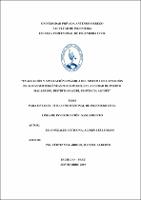Mostrar el registro sencillo del ítem
Evaluación y simulación dinámica del sistema de captación de aguas subterráneas por bombeo, en la ciudad de Puerto Malabrigo, distrito Razuri, provincia Ascope
| dc.contributor.advisor | Vertiz Mlabrigo, Manuel Alberto | |
| dc.contributor.author | Gonzales Anticona, Aldrin Ceulemans | |
| dc.creator | Gonzales Anticona, Aldrin Ceulemans | |
| dc.date.accessioned | 2019-10-21T17:40:31Z | |
| dc.date.available | 2019-10-21T17:40:31Z | |
| dc.date.issued | 2019 | |
| dc.identifier.uri | https://hdl.handle.net/20.500.12759/5552 | |
| dc.description.abstract | En la actualidad la ciudad de Puerto Malabrigo del distrito de Razuri en la provincia Ascope del departamento La Libertad, sufre de un fuerte desabastecimiento de agua potable, la dotación se realiza en promedio tres días a la semana, con un periodo de duración de 1 a 3 horas por día de servicio. Así mismo la fuente de captación que se tiene es un sistema de bombeo con una producción de caudal menor al requerido. La presente tesis surge de la necesidad de dar solución al desabastecimiento de agua potable que sufre la ciudad por más de 30 años, como parte de la contribución social que debe hacer la Universidad Privada Antenor Orrego (UPAO). Ofrezco mi proyecto a la ciudad para así hacer un pequeño aporte (alternativa de solución) al problema emblemático de la ciudad que es el agua potable. La finalidad de la tesis, es que dicha localidad pueda ser abastecida las 24 horas del día con agua potable, para ello propongo un diseño de línea de succión e impulsión nuevo. La tesis garantiza que el agua, de la captación subterránea llegue con una presión dinámica favorable. Por lo tanto, en la presente investigación se logró evaluar y simular dinámicamente el sistema de captación de aguas subterráneas por bombeo de la localidad Puerto Malabrigo, determinando el caudal de bombeo de aguas subterráneas, diámetro de tubería de línea de succión e impulsión, cantidad de horas de bombeo al día, altura dinámica total y potencia de la bomba requerida. Para ello se determinó el periodo de diseño, la población de diseño, dotación por habitante y se halló el caudal promedio. Con el caudal promedio se procedió al cálculo del caudal máximo diario, horario y bombeo, con estos datos se realizó el cálculo del diámetro de la tubería para la línea de succión e impulsión, se hizo un cálculo para determinar la pérdida de carga hidráulica, y altura dinámica total. Con estos datos se calculó la potencia mínima de la bomba requerida para cumplir la función del bombeo de las aguas subterráneas. | es_PE |
| dc.description.abstract | Currently the city of Puerto Malabrigo in the district of Razuri in the province Ascope of the department La Libertad, suffers from a severe shortage of drinking water, the endowment is made on average three days a week, with a period of duration of 1 to 3 hours per day of service. Likewise, the source of collection is a pumping system with a production of less than the required flow. This thesis arises from the need to provide a solution to the shortage of drinking water that the city suffers for more than 30 years, as part of the social contribution to be made by the Universidad Privada Antenor Orrego (UPAO). I offer my project to the city to make a small contribution (alternative solution) to the emblematic problem of the city that is drinking water. The purpose of the thesis is that this town can be supplied 24 hours a day with drinking water, for this I propose a design of suction line and new drive. The thesis guarantees that the water from the underground catchment arrives with a favourable dynamic pressure. Therefore, in the present investigation it was possible to evaluate and dynamically simulate the groundwater collection system by pumping in the town of Puerto Malabrigo, determining the groundwater pumping flow, diameter of the suction and impulsion line pipe, number of pumping hours per day, total dynamic height and power of the required pump. For this purpose, the design period, the design population, staff per inhabitant and the average flow rate were determined. With the average flow we proceeded to calculate the daily maximum flow, hourly and pumping, with these data we calculated the diameter of the pipeline for the suction and impulsion line, a calculation was made to determine the loss of hydraulic load, and total dynamic height. With these data, the minimum power of the pump required to perform the function of pumping groundwater was calculated. | en_US |
| dc.description.uri | Tesis | es_PE |
| dc.format | application/pdf | es_PE |
| dc.language.iso | spa | es_PE |
| dc.publisher | Universidad Privada Antenor Orrego | es_PE |
| dc.relation.ispartofseries | T_ING.CIVIL_1773 | |
| dc.rights | info:eu-repo/semantics/closedAccess | es_PE |
| dc.rights.uri | https://creativecommons.org/licenses/by/4.0/ | es_PE |
| dc.source | Universidad Privada Antenor Orrego | es_PE |
| dc.source | Repositorio Institucional - UPAO | es_PE |
| dc.subject | Simulación | es_PE |
| dc.subject | Bombeo | es_PE |
| dc.title | Evaluación y simulación dinámica del sistema de captación de aguas subterráneas por bombeo, en la ciudad de Puerto Malabrigo, distrito Razuri, provincia Ascope | es_PE |
| dc.type | info:eu-repo/semantics/bachelorThesis | es_PE |
| thesis.degree.level | Título Profesional | es_PE |
| thesis.degree.grantor | Universidad Privada Antenor Orrego. Facultad de Ingeniería | es_PE |
| thesis.degree.name | Ingeniero Civil | es_PE |
| thesis.degree.discipline | Ingeniería Civil | es_PE |
| dc.subject.ocde | https://purl.org/pe-repo/ocde/ford#2.01.00 | |
| renati.type | https://purl.org/pe-repo/renati/type#tesis | |
| renati.level | https://purl.org/pe-repo/renati/level#tituloProfesional | |
| dc.publisher.country | PE | es_PE |
Ficheros en el ítem
Este ítem aparece en la(s) siguiente(s) colección(es)
-
Ingeniería Civil [1260]


